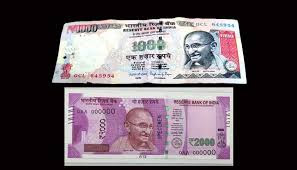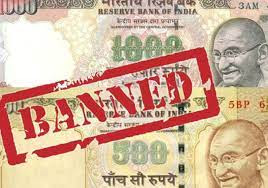"We took a key step to help the honest citizen of India defeat the menace of black money"
The Indian government announced the demonetisation of all Mahatma Gandhi Series 500 and 1,000 banknotes on November 8, 2016. In compensation for the demonetised banknotes, it also announced the printing of fresh 500 and 2,000 banknotes.
Demonetisation
What Is Demonetization?
The practise of removing a monetary unit's ability to be used as legal tender is referred to as demonetisation. Demonetisation, in simple terms, is the process by which demonetised notes are no longer recognised as lawful tender for any purpose.
2016 Indian banknote demonetisation
The Indian government stated on November 8, 2016, that all Mahatma Gandhi Series 500 and 1,000 banknotes would be demonetized. In substitution for the demonetised banknotes, the government announced the issuance of new 500 and 2,000 banknotes. Prime Minister Narendra Modi claimed that the step would minimise the use of illicit and counterfeit cash to fuel unlawful activity and terrorism, as well as curtail the shadow economy and encourage cashless transactions.
Following the announcement of demonetisation, there were weeks of severe cash shortages, causing major economic disruption.
People who wanted to swap their banknotes had to wait in long lines, and the rush to convert currency was blamed for several deaths.
According to a 2018 report from the Reserve Bank of India, nearly 99.3% of the demonetised banknotes were deposited with the RBI, totaling Rs 15.30 lakh crore (15.3 trillion) out of Rs 15.41 lakh crore.
Background
The Indian government had demonetised banknotes twice before, in 1946 and 1978, with the purpose of combating tax evasion via "black money" maintained outside the regular economic system in both cases. In 1978, the Janata Party coalition government demonetised 1,000, 5,000, and 10,000 rupee banknotes in the hopes of reducing counterfeit and black money.
In a report published in 2012, the Central Board of Direct Taxes advised against demonetisation, stating that "demonetization may not be a panacea for confronting black money or the shadow economy, which is predominantly kept in the form of benami properties, bullion, and jewellery." According to statistics from income tax investigations, black money holders retained just 6% or less of their wealth in cash, implying that pursuing this cash would be futile.
Between six and ten months before the proposal to demonetise the 500 and 1,000 rupee banknotes was announced, a report by the State Bank of India (SBI) examined various strategies and impacts of demonetisation. The Reserve Bank of India began preparing new banknotes in May 2016, and in August 2016, the design of 2,000 banknotes was confirmed. When news of upcoming new banknotes broke in the media in October, the printing of new banknotes began.
Following the announcement of demonetisation, prominent businessmen allegedly claimed in an interview that they had received prior tip-offs and rumours warning of the move, and that they "knew what was coming" after seeing leaked photos of new 2,000 notes, allowing them to gamble their money by converting into smaller denominations. Bhawani Singh Rajawat, a BJP MLA from Rajasthan, casually remarked in a video that wealthy businesses were aware about the impending demonetisation before it took place. Later, he denied making the remarks.
The Reserve Bank of India ruled that the demonetised banknotes could be deposited with banks for a period of fifty days until December 30, 2016, according to the Reserve Bank of India. All banks could exchange the banknotes for legal money over the counter. From November 8 to 13, the limit for such exchange was 4,000 per person, which was increased to 4,500 from November 14 to 17, and then lowered to 2,000 from November 18 to 25. The administration had earlier announced that the volume of exchange would be raised after that date, however the exchange of banknotes was fully halted on November 25.
The exercise's major goal, according to the government, is to combat black money, which includes untaxed income, money earned through corruption, illegal commodities sales, and unlawful activities such as human trafficking, as well as counterfeit cash. Other claimed goals were broadening the tax base and increasing the number of taxpayers; reducing the quantity of cash transactions; reducing the financial resources available to terrorists and radical groups like Maoists and Naxalites; and integrating the official and informal economies.
With regard to the goals of the demonetisation process, the government has been accused of' shifting the goalposts.' The stated goal was to combat black money, corruption, and terrorism at first, but as it became clear that practically all currency was being traded, the goals were expanded to include making India a cashless economy, as well as neutralising money held by Maoists, terrorists, and human traffickers.
The government predicted that about 5% of the demonetised banknotes would be permanently withdrawn from circulation, or about 20%. According to a 2018 report from the Reserve Bank of India, 99.3 percent of the demonetised banknotes, or $15.30 lakh crore out of a total of $15.41 lakh crore, were deposited with the banking system. The undeposited banknotes were valued Rs. 10,720 crore. Commentators believed that the government's goal of eradicating black money from the economy had failed.
Persons were allegedly bypassing exchange limitations by making repeated transactions at different bank branches and dispatching hired people, employees, and followers in groups to exchange huge amounts of demonetised banknotes at bank branches.
Between the financial years 2016 and 2017, the number of income tax returns filed climbed from 43.3 million to 52.9 million, which was not a considerable increase compared to the increase between 2015 and 2016. The number of income tax returns filed grew, but the majority of them were from salaried and non-business class workers. Because of the Income Disclosure Scheme 2016, income tax collections increased in the 2017 fiscal year.
Due to long lines at banks and ATMs across India, consumers had difficulty depositing or exchanging demonetised banknotes as a result of the cash shortage caused by demonetisation. For months following demonetisation, ATMs were out of cash.
According to the All India Motor Transport Congress, nearly 800,000 truck drivers and conductors have been affected by the cash scarcity, with 400,000 trucks stalled on major routes across India. Long lines formed at major toll plazas in Gujarat and on the Delhi-Mumbai motorways as toll plaza operators refused to accept the demonetised banknotes.
In the week following the announcement, stock market indices fell to a six-month low as a result of the combined effects of demonetisation and the US presidential election. The BSE SENSEX dropped roughly 1,689 points the day after demonetisation was announced, while the NIFTY 50 dropped over 541 points. The BSE SENSEX index has fallen 565 points and the NIFTY 50 index had fallen below 8100 intraday by the end of intraday trading on November 15, 2016.
Due to demonetisation, global analysts have reduced their projections for India's real GDP growth rate for the financial year 2016–17 by 0.5 to 3%. India's GDP is anticipated to be US$2.25 trillion in 2016, hence a 1% decline in growth equals a US$22.5 billion (1.544 lakh crore) loss for the Indian economy. For the first time since June 2011, quarterly GDP growth rates will fall below 7% for an entire year, according to Societe Generale.
The rate in Q4 2016–17 was 6.1 percent, compared to a projection of 7.1 percent by economists. The rate for the fiscal year 2016–17 was 7.1 percent, down from 8% in the previous year. Economists blamed demonetisation for the decline.
Several people are said to have died as a result of waiting in long lines to exchange their demonetised banknotes. Deaths were also linked to a shortage of medical assistance due to hospitals' refusal to accept demonetised banknotes. Over 100 individuals had died as a result of demonetisation, according to political opposition leaders by the end of December 2016. The government declared in March 2017 that no official report on deaths related to demonetisation has been received. [190] Later in December 2018, then-Finance Minister Arun Jaitley told parliament that four people died as a result of demonetisation: three bank employees and one State Bank of India client.
M. Seeni Ahamed, General Secretary of the Indian National League, filed a public interest litigation (PIL) in the Madras High Court to overturn the demonetisation judgement. The PIL was dismissed by the High Court, which stated that it could not interfere with the government's monetary policies. Similar petitions were also filed before India's Supreme Court. The Supreme Court of India referred all matters relating to demonetisation to a constitutional bench in November 2017 to assess the constitutionality of the move, implementation issues, and violations of people's rights by cash withdrawal limits.
In 2019, India witnessed an economic downturn due to demonetisation and a number of other causes.
Following the surge of the Covid-19 epidemic in India in 2020, a big number of users easily shifted to digital payments. Demonetisation is blamed for the rise in digital payments and cashless transactions.
As of November 2021, there had been a further growth in the number of digital payments and bank notes in circulation.

















0 Comments
Post a Comment